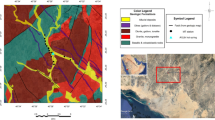Abstract
We present a case study of applying MT (magnetotellurics) and CSAMT (controlled source audio-frequency magnetotellurics) for geophysical exploration in Jiangxia (江夏), which is located in new industrial developing suburb, where artificial noises are severe. In order to know deep buried structure, fracture status, and characteristics of underground geothermal development about 2 km, we acquired MT and CSAMT data to image subsurface structure through inversion and joint interpretation. The electrical terms of the 2D MT inversion can be divided into three ranges of resistivity values: (1) a highly resistive (>350 Ω·m) layer mainly characteristic of limestone, dolomitic limestone, leuttrite, silicarenite, and packsand; (2) an intermediate resistivity (250–350 Ω·m) layer mainly constituted by siliceous shale, siltstone, battie, and ampelitic limestone; and (3) a low resistivity (20–250 Ω·m) layer, from surface to −100 m, which is related to lacustrine alluvium of Quaternary period; the deep low resistivity layer is interpreted to be representative of the geothermal field. The result of the 2D CSAMT inversion reveals two layers of different electrical resistivities: (1) the first resistive layer (20–250 Ω·m), which is related to lacustrine alluvium of Quaternary period and the heat source, and (2) the second resistive layer (250–3 000 Ω·m). The heat source appears to be bounded within the middle of exploration area and shows the N-S trend. Its depth ranges from more than 1.2 to less than 0.7 km, and its resistivity values range from 20 to 250 Ω·m in the northeast part of Jiangxia. Comparing the results of MT and CSAMT method, the positive anomalies are similar and can be assumed to be generated by the same source.
Similar content being viewed by others
References Cited
Arango, C., Marcuello, A., Ledo, J., et al., 2009. 3D Magnetotelluric Characterization of the Geothermal Anomaly in the Llucmajor Aquifer System (Majorca, Spain). Journal of Applied Geophysics, 68(4): 479–488
Bai, D. H., Meju, M. A., Liao, Z. J., 2001. Magnetotelluric Images of Deep Crustal Structure of the Rehai Geothermal Field near Tengchong, Southern China. Geophys. J. Int., 147(3): 677–687
Bartel, L. C., Jacobson, R. D., 1987. Results of a Controlled-Source Audiofrequency Magnetotelluric Survey at the Puhimau Thermal Area, Kilauea Volcano, Hawaii. Geophysics, 52(5): 665–677
Bologna, M. S., Padilha, A. L., Vitorello, I., et al., 2011. Signatures of Continental Collisions and Magmatic Activity in Central Brazil as Indicated by a Magnetotelluric Profile across Distinct Tectonic Provinces. Precambrian Research, 185(1–2): 55–64
Bromley, C., 1993. Tensor CSAMT Study of the Fault Zone between Waikite and Te Kopia Geothermal Fields. Journal of Geomagnetism and Geoelectricity, 45(9): 887–896
Cagniard, L., 1953. Basic Theory of the Magneto-Telluric Method of Geophysical Prospecting. Geophysics, 18(3): 605–635
Garg, S. K., Pritchett, J. W., Wannamaker, P. E., et al., 2007. Characterization of Geothermal Reservoirs with Electrical Surveys: Beowawe Geothermal Field. Geothermics, 36(6): 487–517
Goldstein, M. A., Strangway, D. W., 1975. Audio-Frequency Magnetotellurics with a Grounded Electric Dipole Source. Geophysics, 40(4): 669–683
Harinarayana, T., Abdul, A. K. K., Murthy, D. N., et al., 2006. Exploration of Geothermal Structure in Puga Geothermal Field, Ladakh Himalaya, India by Magnetotelluric Studies. Journal of Applied Geophysics, 58(4): 280–295
Key, K., Weiss, C., 2006. Adaptive Finite-Element Modeling Using Unstructured Grids: The 2D Magnetotelluric Example. Geophysics, 71(6): G291–G299
Mogi, T., Nakama, S., 1993. Magnetotelluric Interpretation of the Geothermal System of the Kuju Volcano, Southwest Japan. Journal of Volcanology and Geothermal Research, 56(3): 297–308
Newman, G. A., Gasperikova, E., Hoversten, G. M., et al., 2008. Three-Dimensional Magnetotelluric Characterization of the Coso Geothermal Field. Geothermics, 37(4): 369–399
Park, M. K., Seol, S. J., Kim, H. J., 2006. Sensitivities of Generalized RRI Method for CSAMT Survey. Geosciences Journal, 10(1): 75–84
Sandberg, S. K., Hohmannt, G. W., 1982. Controlled-Source Audiomagnetotellurics in Geothermal Exploration. Geophysics, 47(1): 100–116
Savin, C., Ritz, M., Join, J. L., et al., 2001. Hydrothermal System Mapped by CSAMT on Karthala Volcano, Grande Comore Island, Indian Ocean. Journal of Applied Geophysics, 48(3): 143–152
Sinharay, R. K., Srivastava, S., Bhattacharya, B. B., 2010. Audiomagnetotelluric Studies to Trace the Hydrological System of Thermal Fluid Flow of Bakreswar Hot Spring, Eastern India: A Case History. Geophysics, 75(5): B187–B195
Smith, J. T., Booker, J. R., 1991. Rapid Inversion of Two and Three-Dimensional Magnetotelluric Data. J. Geophys. Res., 96(B3): 3905–3922
Spichak, V., Manzella, A., 2009. Electromagnetic Sounding of Geothermal Zones. Journal of Applied Geophysics, 68(4): 459–478
Unsworth, M., 2010. Magnetotelluric Studies of Active Continent-Continent Collisions. Surveys in Geophysics, 31(2): 137–161
Volpi, G., Manzella, A., Fiordelisi, A., 2003. Investigation of Geothermal Structures by Magnetotellurics (MT): An Example from the Mt. Amiata Area, Italy. Geothermics, 32(2): 131–145
Vozoff, K., 1991. The Magnetotelluric Method. In: Nabighian, M. N., ed., Electromagnetic Methods in Applied Geophysics: Applications (Vol. 2). Society of Exploration Geophysicists, Tulsa. 641–712
Wannamaker, P. E., 1997a. Tensor CSAMT Survey over the Sulphur Springs Thermal Area, Valles Caldera, New Mexico, U.S.A., Part I: Implications for Structure of the Western Caldera. Geophysics, 62: 451–465
Wannamaker, P. E., 1997b. Tensor CSAMT Survey over the Sulphur Springs Thermal Area, Valles Caldera, New Mexico, U.S.A., Part II: Implications for CSAMT Methodology. Geophysics, 62: 466–476
Zhu, Q. J., Li, F. Z., Wang, X., 2009. Forward Modeling for the Static Effect of AMT and the Resolution of Conductive Folia. Geophysical & Geochemical Exploration, 33(2): 207–211 (in Chinese with English Abstract)
Author information
Authors and Affiliations
Corresponding author
Additional information
This study was supported by the National Natural Science Foundation of China (No. 40974040), the Deep Exploration in China (No. SinoProbe-01-03-02), and the Ministry of Land and Resources of China.
Rights and permissions
About this article
Cite this article
Wu, G., Hu, X., Huo, G. et al. Geophysical exploration for geothermal resources: An application of MT and CSAMT in Jiangxia, Wuhan, China. J. Earth Sci. 23, 757–767 (2012). https://doi.org/10.1007/s12583-012-0282-1
Received:
Accepted:
Published:
Issue Date:
DOI: https://doi.org/10.1007/s12583-012-0282-1




